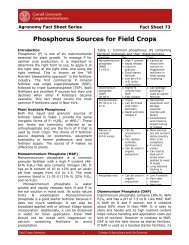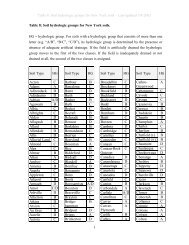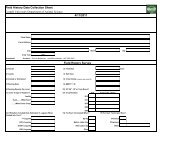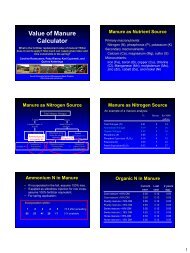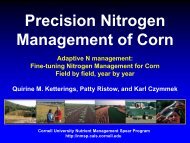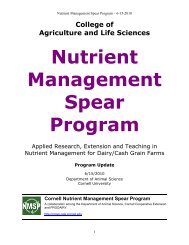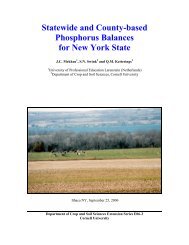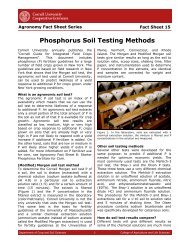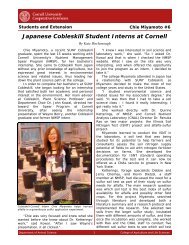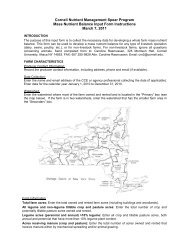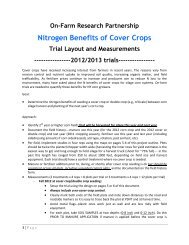Do soybeans respond to starter fertilizer and seed
Do soybeans respond to starter fertilizer and seed
Do soybeans respond to starter fertilizer and seed
You also want an ePaper? Increase the reach of your titles
YUMPU automatically turns print PDFs into web optimized ePapers that Google loves.
Cox, B., <strong>and</strong> Q.M. Ketterings (2002). What’s Cropping Up? 12(2): 1<strong>Do</strong> <strong>soybeans</strong> <strong>respond</strong> <strong>to</strong> <strong>starter</strong> <strong>fertilizer</strong> <strong>and</strong> <strong>seed</strong> inoculum?Bill Cox & Quirine KetteringsDepartment of Crop <strong>and</strong> Soil SciencesNew York farmers typically plant <strong>soybeans</strong> following corn in<strong>to</strong> fields that test mediumhigh<strong>to</strong> high in P. For soils testing medium <strong>to</strong> high in phosphorus, Cornell Universityrecommends the addition of not more than 15 <strong>to</strong> 25 lbs of P 2 O 5 <strong>and</strong> a similar amount of N.Soybeans, however, are usually planted in late May or early June when average soiltemperatures exceed 60 o F <strong>and</strong> soil organic matter mineralization takes place. This raisesthe question whether a small amount of N <strong>and</strong> P <strong>starter</strong> <strong>fertilizer</strong> is really needed <strong>and</strong> how<strong>seed</strong> inoculation affects the <strong>fertilizer</strong> recommendations, especially the N recommendation.We initiated the 3-year study in 1999 <strong>to</strong> examine the response of <strong>soybeans</strong> <strong>to</strong> <strong>starter</strong><strong>fertilizer</strong> application (15 lbs N <strong>and</strong> 55 lbs of P 2 O 5 , applied as 14 gallons/acre of 10-34-0)with or without the addition of Cell-Tech <strong>and</strong> Hi-Stick <strong>seed</strong> inoculum on fields testing highin soil test P (Morgan extractable P of 9 <strong>to</strong> 39 lbs P/acre). Responses were tested in fieldsthat had never been planted <strong>to</strong> <strong>soybeans</strong> or had been planted 4 <strong>to</strong> 5 times <strong>to</strong> <strong>soybeans</strong> in the1990s. We tested in fields with or without a soybean his<strong>to</strong>ry because <strong>seed</strong> inoculum isrecommended in fields without a soybean his<strong>to</strong>ry but not in fields with a soybean his<strong>to</strong>ry.The 1999 growing season was extremely dry, 2000 was very wet, <strong>and</strong> 2001 wasmoderately dry.When averaged across the 3 years, the use of Cell-Tech inoculum increasedsoybean yields when compared with the check (no <strong>starter</strong> <strong>fertilizer</strong> or inoculum) in fieldswith a soybean his<strong>to</strong>ry (Table 1). Likewise, the use of Hi-Stick inoculum plus <strong>starter</strong><strong>fertilizer</strong> increased soybean yields when compared with the <strong>starter</strong> <strong>fertilizer</strong> treatment.Apparently, <strong>soybeans</strong> can <strong>respond</strong> <strong>to</strong> the use of <strong>seed</strong> inoculum in fields with a soybeanhis<strong>to</strong>ry under New York growing conditions. The use of <strong>starter</strong> <strong>fertilizer</strong>, however, did notincrease soybean yields in the presence or absence of inoculum in fields with a soybeanhis<strong>to</strong>ry. Apparently, <strong>soybeans</strong> do not require <strong>starter</strong> P <strong>fertilizer</strong> in fields that test high in P.When averaged across the 3 years, the use of Cell-Tech <strong>and</strong> Hi-Stick <strong>seed</strong> inoculumincreased soybean yields in the presence or absence of <strong>starter</strong> <strong>fertilizer</strong> in fields withoutsoybean his<strong>to</strong>ry (Table 2). Averaged across the 3 years, no differences in yield increasewere observed between Cell-Tech <strong>and</strong> Hi-Stick inoculums. Also, the use of <strong>starter</strong><strong>fertilizer</strong> did not increase soybean yields in the presence or absence of inoculum.Apparently, <strong>soybeans</strong> do not <strong>respond</strong> <strong>to</strong> <strong>starter</strong> <strong>fertilizer</strong> N <strong>and</strong> P under New York growingconditions even in fields with no soybean his<strong>to</strong>ry.We recommend the use of inoculum for all soybean plantings, even in fields with asoybean his<strong>to</strong>ry. Also, we do not recommend any <strong>starter</strong> <strong>fertilizer</strong> P for <strong>soybeans</strong> in fieldsthat test high or very high in P (≥ 9 lbs P/acre Morgan extraction). Finally, we do notrecommend the use of <strong>starter</strong> N <strong>fertilizer</strong> for <strong>soybeans</strong>, even on fields with no soybeanhis<strong>to</strong>ry.1
Cox, B., <strong>and</strong> Q.M. Ketterings (2002). What’s Cropping Up? 12(2): 1Table 1. Soybean yields under different inoculum <strong>and</strong> <strong>starter</strong> <strong>fertilizer</strong>combinations in fields with soybean his<strong>to</strong>ry in 1999, 2000, <strong>and</strong> 2001 atthe Aurora Research Farm.Treatments 1999 2000 2001 MeanCell-TechHi-Stick + Starter †Cell-Tech+StarterHi-StickStarterCheck------------------------bu/acre--------------------------303230313132LSD 0.05 NS 2 3 2† Starter <strong>fertilizer</strong> was applied at a rate of 15 lbs N <strong>and</strong> 55 lbs P 2 O 5 /acre.Soils tested high for phosphorus availability.464546444342454242424039404039393838Table 2. Soybean yields under different inoculum <strong>and</strong> <strong>starter</strong> <strong>fertilizer</strong>combinations in fields without soybean his<strong>to</strong>ry in 1999, 2000, <strong>and</strong> 2001at the Aurora Research Farm.Treatments 1999 2000 2001 MeanCell-Tech+Starter †Cell-TechHi-Stick + StarterHi-StickStarterCheck------------------------bu/acre--------------------------252523222421LSD 0.05 NS 7 3 2† Starter <strong>fertilizer</strong> was applied at a rate of 15 lbs N <strong>and</strong> 55 lbs P 2 O 5 /acre.Soils tested high for phosphorus availability.5249505145473535353232323736363534332



